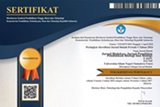Specific primer design for microbiome profiling of the dengue vector Aedes aegypti based on 16S ribosomal DNA
Abstract
Identification of the microbiome in the dengue vector Aedes aegypti is crucial for developing effective vector control strategies. The 16S ribosomal DNA (rDNA) gene is frequently used as a genetic marker in microbiome analysis. This study aimed to design and validate specific primers to identify Serratia and Wolbachia in Aedes aegypti. The study employed Primer-BLAST using DNA sequence data from NCBI (accession numbers OR801069.1 for Serratia and MN046789.1 for Wolbachia). The designed primers included: for Serratia—Forward 5’-GTCGACTTTGATCCTGGCTCAG-3’ and Reverse 5’-TCAGCCTGTTTCCAATGACC-3’; and for Wolbachia—Forward 5’-TGATGAAGTTAGCTTGCTAACG-3’ and Reverse 5’-ACGGCTGAGTGAACGGGTG-3’. Validation was conducted through PCR, followed by visualization of the amplification products using 1.5% agarose gel electrophoresis. PCR amplification revealed distinct DNA bands of 766 bp for Serratia and 556 bp for Wolbachia, confirming primer specificity. The Sanger sequencing results were validated using BLAST, showing high alignment with reference strains in the GenBank database. The specific primers based on the 16S rDNA gene are effective for detecting Serratia and Wolbachia in Aedes aegypti.
Keywords
Full Text:
PDFReferences
Al-Atiyat, R. M., & Aljumaah, R. S. (2014). Genetic distances and phylogenetic trees of different Awassi sheep populations based on DNA sequencing. Genetics and Molecular Research, 13(3), 6557–6568. https://doi.org/10.4238/2014.August.26.6
Ames, N. J., Ranucci, A., Moriyama, B., & Wallen, G. R. (2017). The Human Microbiome and Understanding the 16S rDNA Gene in Translational Nursing Science. Nursing Research, 66(2), 184–197. https://doi.org/10.1097/NNR.0000000000000212
Ant, T. H., Mancini, M. V., McNamara, C. J., Rainey, S. M., & Sinkins, S. P. (2023). Wolbachia -Virus interactions and arbovirus control through population replacement in mosquitoes. Pathogens and Global Health, 117(3), 245–258. https://doi.org/10.1080/20477724.2022.2117939
Bartoš, O., Chmel, M., & Swierczková, I. (2024). The overlooked evolutionary dynamics of 16S rDNA revises its role as the “gold standard” for bacterial species identification. Scientific Reports, 14(1), 9067. https://doi.org/10.1038/s41598-024-59667-3
Da Silva, W. J., Pilz-Júnior, H. L., Heermann, R., & Da Silva, O. S. (2020). The great potential of entomopathogenic bacteria Xenorhabdus and Photorhabdus for mosquito control: a review. Parasites and Vectors, 13(1), 1–14. https://doi.org/10.1186/s13071-020-04236-6
Facchinelli, L., Badolo, A., & McCall, P. J. (2023). Biology and Behaviour of Aedes aegypti in the Human Environment: Opportunities for Vector Control of Arbovirus Transmission. Viruses, 15(3), 636. https://doi.org/10.3390/v15030636
Fernández, A., Segura-Alabart, N., & Serratosa, F. (2023). The MultiFurcating Neighbor-Joining Algorithm for Reconstructing Polytomic Phylogenetic Trees. Journal of Molecular Evolution, 91(6), 773–779. https://doi.org/10.1007/s00239-023-10134-z
Ferreira, Q. R., Lemos, F. F. B., Moura, M. N., Nascimento, J. O. de S., Novaes, A. F., Barcelos, I. S., FeDNAndes, L. A., Amaral, L. S. de B., Barreto, F. K., & Melo, F. F. de. (2023). Role of the Microbiome in Aedes spp. Vector Competence: What Do We Know? Viruses, 15(3), 779. https://doi.org/10.3390/v15030779
Fuks, G., Elgart, M., Amir, A., Zeisel, A., Turnbaugh, P. J., Soen, Y., & Shental, N. (2018). Combining 16S rDNA gene variable regions enables high-resolution microbial community profiling. Microbiome, 6(1), 17. https://doi.org/10.1186/s40168-017-0396-x
Gan, S. J., Leong, Y. Q., bin Barhanuddin, M. F. H., Wong, S. T., Wong, S. F., Mak, J. W., & Ahmad, R. B. (2021). Dengue fever and insecticide resistance in Aedes mosquitoes in Southeast Asia: a review. Parasites & Vectors, 14(1), 315. https://doi.org/10.1186/s13071-021-04785-4
Gunara, N. P., Joelianto, E., & Ahmad, I. (2023). Identification of Aedes aegypti and Aedes albopictus eggs based on image processing and elliptic fourier analysis. Scientific Reports, 13(1), 17395. https://doi.org/10.1038/s41598-023-28510-6
Hall, B. G. (2013). Building Phylogenetic Trees from Molecular Data with MEGA. Molecular Biology and Evolution, 30(5), 1229–1235. https://doi.org/10.1093/molbev/mst012
Hassler, H. B., Probert, B., Moore, C., Lawson, E., Jackson, R. W., Russell, B. T., & Richards, V. P. (2022). Phylogenies of the 16S rDNA gene and its hypervariable regions lack concordance with core genome phylogenies. Microbiome, 10(1), 104. https://doi.org/10.1186/s40168-022-01295-y
Hussain, M., Etebari, K., & Asgari, S. (2023). Analysing inhibition of dengue virus in Wolbachia-infected mosquito cells following the removal of Wolbachia. Virology, 581, 48–55. https://doi.org/10.1016/j.virol.2023.02.017
Johnson, J. S., Spakowicz, D. J., Hong, B.-Y., Petersen, L. M., Demkowicz, P., Chen, L., Leopold, S. R., Hanson, B. M., Agresta, H. O., Gerstein, M., Sodergren, E., & Weinstock, G. M. (2019). Evaluation of 16S rDNA gene sequencing for species and strain-level microbiome analysis. Nature Communications, 10(1), 5029. https://doi.org/10.1038/s41467-019-13036-1
Jupatanakul, N., Pengon, J., Selisana, S. M. G., Choksawangkarn, W., Jaito, N., Saeung, A., Bunyong, R., Posayapisit, N., Thammatinna, K., Kalpongnukul, N., Aupalee, K., Pisitkun, T., & Kamchonwongpaisan, S. (2020). Serratia marcescens secretes proteases and chitinases with larvicidal activity against Anopheles dirus. Acta Tropica, 212, 105686. https://doi.org/10.1016/j.actatropica.2020.105686
Khan, M. B., Yang, Z.-S., Lin, C.-Y., Hsu, M.-C., Urbina, A. N., Assavalapsakul, W., Wang, W.-H., Chen, Y.-H., & Wang, S.-F. (2023). Dengue overview: An updated systemic review. JouDNAl of Infection and Public Health, 16(10), 1625–1642. https://doi.org/10.1016/j.jiph.2023.08.001
Knoblauch, S., Su Yin, M., Chatrinan, K., de Aragão Rocha, A. A., Haddawy, P., Biljecki, F., Lautenbach, S., Resch, B., Arifi, D., Jänisch, T., Morales, I., & Zipf, A. (2024). High-resolution mapping of urban Aedes aegypti immature abundance through breeding site detection based on satellite and street view imagery. Scientific Reports, 14(1), 18227. https://doi.org/10.1038/s41598-024-67914-w
Konkon, A. K., Padonou, G. G., Osse, R., Salako, A. S., Zoungbédji, D. M., Sina, H., Sovi, A., Tokponnon, F., Aïkpon, R., Noukpo, H., Baba-Moussa, L., & Akogbéto, M. C. (2023). Insecticide resistance status of Aedes aegypti and Aedes albopictus mosquitoes in southern Benin, West Africa. Tropical Medicine and Health, 51(1), 22. https://doi.org/10.1186/s41182-023-00514-y
Kozlova, E. V, Hegde, S., Roundy, C. M., Golovko, G., Saldaña, M. A., Hart, C. E., Anderson, E. R., Hornett, E. A., Khanipov, K., Popov, V. L., Pimenova, M., Zhou, Y., Fovanov, Y., Weaver, S. C., Routh, A. L., Heinz, E., & Hughes, G. L. (2021). Microbial interactions in the mosquito gut determine Serratia colonization and blood-feeding propensity. The ISME Journal, 15(1), 93–108. https://doi.org/10.1038/s41396-020-00763-3
Kozyreva, A. A., Zlotina, A. M., Golovkin, A. S., Kalinina, O. V., & Kostareva, A. A. (2021). Primer designing in Primer-BLAST. Translational Medicine, 8(3), 37–52. https://doi.org/10.18705/2311-4495-2021-8-3-37-52
Kularatne, S. A., & Dalugama, C. (2022). Dengue infection: Global importance, immunopathology and management. Clinical Medicine, 22(1), 9–13. https://doi.org/10.7861/clinmed.2021-0791
Kumar, S., Stecher, G., Li, M., Knyaz, C., & Tamura, K. (2018). MEGA X: Molecular Evolutionary Genetics Analysis across Computing Platforms. Molecular Biology and Evolution, 35(6), 1547–1549. https://doi.org/10.1093/molbev/msy096
Lee, J. H., Kim, H. W., Mustafa, B., Lee, H. Il, & Kwon, H. W. (2023). The relationships between microbiome diversity and epidemiology in domestic species of malaria-mediated mosquitoes of Korea. Scientific Reports, 13(1), 1–12. https://doi.org/10.1038/s41598-023-35641-3
Liang, X., Liu, J., Bian, G., & Xi, Z. (2020). Wolbachia Inter-Strain Competition and Inhibition of Expression of Cytoplasmic Incompatibility in Mosquito. Frontiers in Microbiology, 11. https://doi.org/10.3389/fmicb.2020.01638
Masluhiya AF, S., Wibowo, R. C. A., & Luthfin, A. (2022). Eksplorasi Sebaran Penyakit Demam Berdarah Dengue (DBD) dan Pneumonia di Kota Malang. JUMANTIK (Jurnal Ilmiah Penelitian Kesehatan), 7(2), 134. https://doi.org/10.30829/jumantik.v7i2.10402
Miesen, P., & van Rij, R. P. (2019). Crossing the Mucosal Barrier: A Commensal Bacterium Gives Dengue Virus a Leg-Up in the Mosquito Midgut. Cell Host & Microbe, 25(1), 1–2. https://doi.org/10.1016/j.chom.2018.12.009
Miranti, K. A., Wahyuni, S., Permana, T. I., Fatmawati, D., & Nuryady, M. M. (2023). Desain Primer Spesifik Vektor Dengue Aedes aegypti Berdasarkan DNA Pengkode ITS-1, 5.8S Ribosomal DNA, dan ITS-2. Jurnal Veteriner, 24(1), 76–82. https://doi.org/10.19087/jveteriner.2023.24.1.76
Medeiros, M. C., Seabourn, P. S., Rollins, R. L., & Yoneishi, N. M. (2022). Mosquito microbiome diversity varies along a landscape-scale moisture gradient. Microbial ecology, 1-8. https://doi.org/10.1007/s00248-021-01865-x
Mohd Salleh, M. H., Esa, Y., & Gan, H. M. (2023). Characterization of the complete mitochondrial genome of the critically endangered Southern River Terrapin, Batagur affinis affinis (Reptilia: Geoemydidae). Mitochondrial DNA Part B, 8(7), 719–722. https://doi.org/10.1080/23802359.2023.2222851
Montenegro, D., Cortés-Cortés, G., Balbuena-Alonso, M. G., Warner, C., & Camps, M. (2024). Wolbachia-based emerging strategies for control of vector-transmitted disease. Acta Tropica, 260, 107410. https://doi.org/10.1016/j.actatropica.2024.107410
Rofiah, S. K., Nasikh Nasikh, & Grisvia Agustin. (2022). Rural Tourism As an Economic Potential for People in Malang Raya. InteDNAtional JouDNAl of Economics and Management Research, 1(3), 130–143. https://doi.org/10.55606/ijemr.v1i3.50
Sofiana, L., Rokhmayanti, R., Martini, M., & Wulandari, D. A. (2023). Insecticide resistance of Aedes aegypti in Indonesia: a systematic review. International Journal of Public Health Science, 12(3), 950-964. https://doi.org/10.11591/ijphs.v12i3.22843
Scolari, F., Casiraghi, M., & Bonizzoni, M. (2019). Aedes spp. and Their Microbiota: A Review. Frontiers in Microbiology, 10. https://doi.org/10.3389/fmicb.2019.02036
Supriyono, S., Soviana, S., Musyaffa, M. F., Novianto, D., & Hadi, U. K. (2023). Morphological characteristic of dengue vectors Aedes aegypti and Ae. albopictus (Family: Culicidae) using advanced light and scanning electron microscope. Biodiversitas Journal of Biological Diversity, 24(2). https://doi.org/10.13057/biodiv/d240227
Silalahi, C. N., Tu, W.-C., Chang, N.-T., Singham, G. V., Ahmad, I., & Neoh, K.-B. (2022). Insecticide Resistance Profiles and Synergism of Field Aedes aegypti from Indonesia. PLOS Neglected Tropical Diseases, 16(6), e0010501. https://doi.org/10.1371/journal.pntd.0010501
Tian, N., Zheng, J.-X., Guo, Z.-Y., Li, L.-H., Xia, S., Lv, S., & Zhou, X.-N. (2022). Dengue Incidence Trends and Its Burden in Major Endemic Regions from 1990 to 2019. Tropical Medicine and Infectious Disease, 7(8), 180. https://doi.org/10.3390/tropicalmed7080180
Vulu, F., Futami, K., Sunahara, T., Mampuya, P., Bobanga, T. L., Mumba Ngoyi, D., & Minakawa, N. (2024). Geographic expansion of the introduced Aedes albopictus and other native Aedes species in the Democratic Republic of the Congo. Parasites & Vectors, 17(1), 35. https://doi.org/10.1186/s13071-024-06137-4
Zou, Y., Zhang, Z., Zeng, Y., Hu, H., Hao, Y., Huang, S., & Li, B. (2024). Common Methods for Phylogenetic Tree Construction and Their Implementation in R. Bioengineering, 11(5), 480. https://doi.org/10.3390/bioengineering11050480
DOI: http://dx.doi.org/10.30821/biolokus.v8i1.3975
Refbacks
- There are currently no refbacks.
Copyright (c) 2025 Jurnal Biolokus: Jurnal Penelitian Pendidikan Biologi dan Biologi
indexed by :












